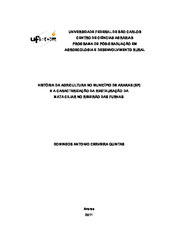| dc.contributor.author | Quintas, Domingos Antonio Cerveira | |
| dc.date.accessioned | 2016-06-02T18:57:35Z | |
| dc.date.available | 2011-05-24 | |
| dc.date.available | 2016-06-02T18:57:35Z | |
| dc.date.issued | 2011-01-31 | |
| dc.identifier.citation | QUINTAS, Domingos Antonio Cerveira. History of agriculture in the city of Araras (SP) and characterization of the restoration of riparian vegetation in the Ribeirão das Furnas. 2011. 106 f. Dissertação (Mestrado em Ciências Agrárias) - Universidade Federal de São Carlos, São Carlos, 2011. | por |
| dc.identifier.uri | https://repositorio.ufscar.br/handle/ufscar/107 | |
| dc.description.abstract | The objectives of this study were to characterize the evolution of agriculture in the history of the city of Araras, SP and the study of the current stage of development of reforestation began in 1998 in the fragment of the riparian forest of Ribeirao das Furnas. The colonization of land in the municipality began in 1727 in a scenario where an estimated 82% of the land was occupied by forests and 18% were fields and swampy areas. There were distinct cycles of occupation and properties of lands that culminated in the current scenario of monoculture of cane sugar and a few fragments of native forest remnants. The almost total destruction of riparian vegetations during the colonial occupation, agricultural and urban of Sao Paulo, caused a large impact on water quality and its preservation. The heavy siltation of rivers and lakes undertook the main sources of supply. The Association of Environmental Preservation and Protection of Araras promoted the recovery of degraded areas, recomposing riparian vegetations, producing and planting seedlings of native species. Through four plots 5X20m equidistant, carried out the floristic and phytosociological survey, distributed in the central position in relation to the width of riparian vegetation. After the quantification and identification of species were applied index of diversity, equability and importance value of arboreal species. Were identified 48 arboreal individuals with DBH ≥ 5 cm, grouped into 13 families, 19 genera and 22 species. The most important value, IVI, 52,84, was the species Schinus terebinthifolius (Anacardiaceae). The indices of Shannon had amplitudes from 0,301 to 1,035 and the indices of equability in vii plots varied between 0,224 and 0,771, indicating the occurrence of gradients, characterizing the development of reforested vegetation is not uniform. The equability index (e) indicates that the forest is fragmenting into two islands of vegetation. Conclude that the restoration of forests is a process that goes beyond the planting of seedlings of arboreal species, demand fundamental care in the early years of the project, until the forest reaches a stage of development which allows its sustainability. | eng |
| dc.format | application/pdf | por |
| dc.language | por | por |
| dc.publisher | Universidade Federal de São Carlos | por |
| dc.rights | Acesso Aberto | por |
| dc.subject | Agroecologia | por |
| dc.subject | Reflorestamento | por |
| dc.subject | Sustentabilidade | por |
| dc.subject | Microbacia hidrográfica | por |
| dc.subject | Mata ciliar | por |
| dc.title | História da agricultura no município de Araras (SP) e a caracterização da restauração da mata ciliar no Ribeirão das Furnas | por |
| dc.title.alternative | History of agriculture in the city of Araras (SP) and characterization of the restoration of riparian vegetation in the Ribeirão das Furnas | eng |
| dc.type | Dissertação | por |
| dc.contributor.advisor1 | Stolf, Rubismar | |
| dc.description.resumo | Os objetivos deste estudo foram caracterizar a evolucao agricola na historia do municipio de Araras, SP e o estudo do atual estagio de desenvolvimento do reflorestamento iniciado no ano de 1998 no fragmento de mata ciliar do Ribeirao das Furnas. A colonizacao das terras do municipio teve inicio em 1727 num cenario onde se estima que 82% das terras eram ocupados por florestas e 18% eram de campos e areas alagadicas. Ocorreram ciclos distintos de ocupacao e propriedade das terras, que culminaram no atual cenario de monocultura de cana-de-acucar e poucos fragmentos de mata nativa remanescentes. A destruicao das matas ciliares em sua quase totalidade durante a ocupacao colonial, agricola e urbana do Estado de Sao Paulo, causou grande impacto na qualidade da agua e sua preservacao. Os intensos assoreamentos de rios e lagos comprometeram as principais fontes de abastecimento. A APPA - Associacao de Protecao e Preservacao Ambiental de Araras promoveu a recuperacao de areas degradadas, recompondo matas ciliares produzindo e plantando mudas de especies nativas. Realizou-se o levantamento floristico e fitossociologico por meio de quatro parcelas de 5X20m equidistantes, distribuidas na posicao central em relacao a largura da mata ciliar. Apos a quantificacao e identificacao das especies foram aplicados os indices de diversidade, equabilidade e valor de importancia das especies arboreas. Foram identificados 48 individuos arboreos com DAP ≥ 5 cm, agrupados em 13 familias, 19 generos e 22 especies. O maior valor de v importancia, IVI, 52,84, foi da especie Schinus terebinthifolius (Anacardiaceae). Os indices de Shannon tiveram amplitudes de 0,301 a 1,035 e os indices de equabilidade nas parcelas variaram entre 0,224 e 0,771, indicando a ocorrencia de gradientes, caracterizando que o desenvolvimento da mata reflorestada nao e uniforme. Os indices de equabilidade (e) indicam que a mata esta se fragmentando em duas ilhas de vegetacao. Conclui-se que a restauracao de matas e um processo que vai alem do plantio das mudas de especies arboreas, demanda cuidados fundamentais nos primeiros anos do empreendimento, ate que a mata alcance sua sustentabilidade. | por |
| dc.publisher.country | BR | por |
| dc.publisher.initials | UFSCar | por |
| dc.publisher.program | Programa de Pós-Graduação em Agroecologia e Desenvolvimento Rural - PPGADR-Ar | por |
| dc.subject.cnpq | CIENCIAS AGRARIAS | por |
| dc.contributor.authorlattes | http://lattes.cnpq.br/5786606684404295 | por |
